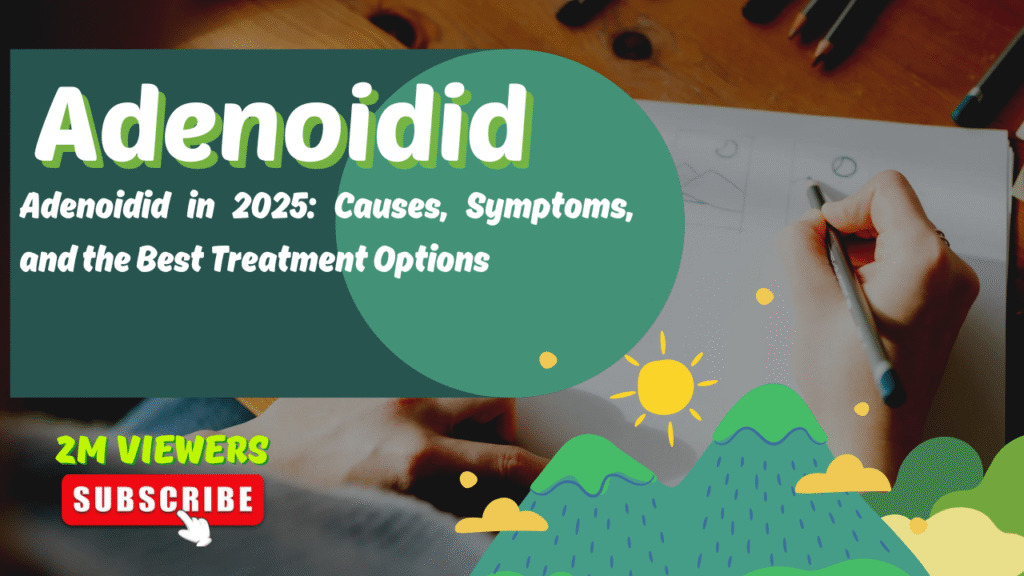Adenoidid in 2025: Causes, Symptoms, and the Best Treatment Options
Table of Contents
Introduction
In 2025, conditions like adenoid hyperplasia remain some of the most common diagnoses in the pediatric population, and some adult patients, as well. The adenoids are considered immune organs and are small, paired, and unencapsulated. They are located in the upper throat region, just behind the nasal cavity. They act as filters and a first line of defense against germs that enter the body through the mouth and nasal passages. They also get swollen and infected, and if this occurs repeatedly, adenoid hyperplasia or adenoid hypertrophy develops.
Some parents fail to identify this ailment in its early stages because they confuse it with viral upper respiratory infections or allergies. However, persistent inflammation of the adenoids can lead to stridor, otitis media, and sleep disturbance. The year 2025 and beyond will be a new frontier in terms of progress in the understanding of the causes of adenoidal hypertrophy, its implications, and the potential treatment options to optimize early intervention and improve the prospects of recovery and the quality of life.

What Are Adenoids and Why Do They Matter
Adenoids refer to small pieces of lymphatic tissue found behind the nose and along with the tonsils; adenoids form a significant part of the immune system as a defense. The distinction between tonsils and adenoids is their respective locations. Tongue to the back of the throat, adenoids are positioned high and are out of sight.
In the case of adenoids, their location can make diagnosis difficult. Inflammation can go unnoticed until it causes chronic nasal blockage, snoring, or repeated ear infection. In children especially, swollen adenoids can impact speech, and affect a child’s breathing and sleeping. ENT specialists are able to help parents and children understand the concepts better by using photographs of adenoids and tonsils.
The location of the ear, nose, throat and adenoids explains the ear-related problems associated with adenoid infections. These tubes become blocked and inflamed, causing ear pain and fluid buildup. Blocked Eustachian tubes prevent proper drainage of fluid buildup and attempt to equalize ear pressure.
Causes of Adenoidid
There are different reasons behind Adenoidal Hypertrophy (ICD-10: J35.2) which include infections and allergies. Review some of the more common ones:
- Recurrent Infections:
Whenever a bacterium or virus penetrates the body, a body response will be provoked, which leads to an increase in the size of the adenoids. After a while, the enlargement becomes permanent, resulting in chronic inflammation of the adenoids. - Allergic Reactions:
Adenoids can increase in size due to chronic allergy symptoms. Specific pollen, dust, or animal dander triggers can cause an adenoid enlargement. That is especially in children living in highly developed or polluted urban areas - Environmental Pollution:
Cigarette smoke, auto exhaust, and indoor pollutants which can be irritating to the nasal passages will cause adenoid hypertrophy. - Genetic Factors:
Some people have an inherited tendency towards developing enlarged adenoids. This is the genetic factor and is seen in family lines where the children, with parents or siblings, have undergone adenoidectomies in childhood.
In severe instances, the adenoids and turbinates can both become inflamed, resulting in a considerable degree of airway obstruction. The more completely the cause is understood, the more effective the strategies for prevention and control will be.

Symptoms of Adenoidid
The manifestations of Adenoidid depend on how the adenoids are swollen or infected. The most common ones are:
- Nasal blockage with mouth breathing
- Snoring or breathing pauses in sleep (sleep apnea)
- Voice with a nasal quality
- Ear infections
- Tonsillitis with swallowing difficulty
- Sleep is restless, and fatigue
In adenoides en niños, there are more evident facial features such as mouth open posture, disrupted sleep, and possible speech delay. Frequent snoring or mouth breathing points to adenoidal hypertrophy.
Parents appreciate pictures of the tonsils, adenoids, or medical photos of the adenoids to better visualize the condition. Early diagnosis leads to better results in treatment.
Diagnosis of Adenoidid
To confirm Adenoidid, doctors perform a series of evaluations:
- Physical Examination:
The ENT checks for any swelling in the throat, ears, and nose. - Endoscopy:
A small, flexible tube with a camera attached to it is inserted into the nose, looking for a direct view of the adenoids. It gives precise details about the size and extent of the blockage. - Imaging Tests:
The location of the adenoids and tonsils can now be determined using X-rays and other digital scans to assess how enlarged they are as well. - Medical Coding (ICD-10):
A physician assigns a condition using a coding system. Hypertrophy of the adenoids is coded as J35.2 and hypertrophy of the tonsils and adenoids as J35.3. This provides uniformity for record-keeping and is used for insurance purposes as well.
Complications of Untreated Adenoidid
The consequences of untreated adenoid hypertrophy can significantly impact one’s quality of life in several ways, such as:
- Sleep Apnea: During sleep, enlarged adenoids can obstruct the airway, resulting in breath pauses and poor quality sleep.
- Ear Infections: Enlarged adenoids can also obstruct the Eustachian tubes, resulting in fluid accumulation behind the eardrum and ear infections.
- Speech and Facial Changes: In children, chronic mouth breathing can result in certain speech defects as well as abnormal facial development.
- Sinus Infections: Chronic sinusitis may occur due to blocked nasal passages.
Lastly, in children, recurrent infections may negatively impact their overall health and academic performance, necessitating prompt medical treatment.

Modern Treatment Options for Adenoidid (2025)
As of 2025, treatment approaches for adenoiditis have more successfully incorporated new technologies and techniques alongside more traditional practices.
1. Non-Surgical Treatments
For mild cases, healthcare professionals take a watchful, non-invasive approach:
- Medications: Antibiotics and nasal corticosteroid sprays are prescribed for treating bacterial infections and for reducing inflammation.
- Allergy Management: Detecting allergy triggers and controlling them helps minimize inflammation.
- Home Remedies: Many people ask, how can adenoids shrink without needing surgery? Saline nasal sprays, humidifiers, and clean, breathable air can facilitate the body’s healing.
- Nutritional Support: Foods rich in vitamins A and C, in addition to zinc, stimulate the immune system, which can help fend off infections.
2. Surgical Treatments (Adenoidectomy)
Generally, adenoidectomy is the next most appropriate step in treatment when symptoms are persistent. It is a straightforward and brief procedure, the purpose of which is to remove the inflamed adenoidal tissue. It can be done in a matter of days and thus you will have several days of recovery afterwards.
Trained professionals routinely include this procedure in their quarterly scheduled operations together with adenoid removal, ear tube insertion, and tonsillectomy, especially in cases when hearing and fluid retention issues are present.
Concerns regarding recurrence are understandable. For example, parents often ask, “Do your adenoids grow back?” This is highly unlikely. There is a small chance that very young children still have some regressed tissue, but that too is a rarity.
Adenoidid in Children vs Adults
Adenoidid is more predominant in children because they have larger adenoids which are more active in immune defense. In children, inflamed tonsils and adenoids can lead to chronic snoring, behavioral problems due to inadequate sleep, infection, and frequent illness.
Conversely, adults typically suffer from adenoidid as a result of chronic, untreated simple allergies, pollution, or sinus infections. Although adenoidectomies are uncommon in adults, they are performed in cases where the patient suffers from chronic sinus or breathing complications.
Latest Advancements in Adenoidid Treatment (2025 Updates)
By 2025, advances in Medical Technology changed the diagnosis and treatment of Adenoidid. Some of the new developments include:
- Laser-Assisted Adenoidectomy:
Laser-Assisted Adenoidectomy During this new surgical approach, surgeons use lasers to remove adenoids, resulting in less blood loss and quicker recovery. - AI Imaging Analysis:
AI Imaging Analysis Artificial intelligence aids ENT specialists in the early diagnosis of inflamed adenoids and tonsils by analyzing photographs. - Cryotherapy:
Cryotherapy: This non-invasive approach employs very low temperatures to shrink swollen tissues without the need for major surgical procedures. - Immune-Based Therapies:
Immune-Based Therapies Development during this year focuses on improving new immune therapies designed to help prevent recurrent hypertrophy of the tonsils and adenoids.
The new procedures minimize the length of time a patient is in a hospital and facilitate quicker recovery than the old methods.

Adenoidid Recovery and Aftercare
Postoperative care or care following medical treatment is critical to the success of any medical intervention. Patients are advised to:
- Take several days to rest.
- Have warm liquids, spicy, and hard foods are to be avoided.
- Use saline sprays to keep the nasal passages moist.
- Stay away from smoke and pollutants
Parents of young children should look for any signs of infection and keep scheduled follow-up visits with the doctor. After this period, most patients ease back into normal, unlabored breathing, improved quality of sleep, and heightened levels of energy.
Prevention Tips for Adenoidid
Though it may not be possible to prevent Adenoidid altogether, implementing these recommendations may help reduce the risk:
- Practice good hygiene through frequent handwashing.
- Reduce exposure to polluted indoor air through the use of air filters and purifiers.
- Steer clear of cigarette smoke.
- Manage allergies proactively to prevent the escalation into persistent inflammation.
- Maintain a well-balanced diet to promote the immune system.
Both children and adults may be able to prevent frequent flare-ups of adenoids with appropriate care and attention.
Conclusion
There may be an impression of little significance; however, should adenoids be neglected, they will lead to obstructive breathing and sleeping problems. Treatment will, however, be quicker, safer, and more effective after 2025 with advancements in surgical techniques.
Understanding the condition as best as possible is always needed to ensure best recovery possible, regardless of whether the individual center has a primary focus of performing adenoidectomy, seeking nonsurgical adenoid shrinking options, or distinguishing the tonsils from the adenoids. Compensation for the burdens of chronic adenoid problems represents the best possible quality of life, and that is only possible through positive, proactive steps of prompt diagnosis and treatment.